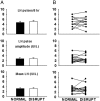Accumulated deep sleep is a powerful predictor of LH pulse onset in pubertal children
- PMID: 25490277
- PMCID: PMC4333042
- DOI: 10.1210/jc.2014-3563
Accumulated deep sleep is a powerful predictor of LH pulse onset in pubertal children
Abstract
Context: During puberty, reactivation of the reproductive axis occurs during sleep, with LH pulses specifically tied to deep sleep. This association suggests that deep sleep may stimulate LH secretion, but there have been no interventional studies to determine the characteristics of deep sleep required for LH pulse initiation.
Objective: The objective of this study was to determine the effect of deep sleep fragmentation on LH secretion in pubertal children.
Design and setting: Studies were performed in a clinical research center.
Subjects: Fourteen healthy pubertal children (11.3-14.1 y) participated in the study.
Interventions: Subjects were randomized to two overnight studies with polysomnography and frequent blood sampling, with or without deep sleep disruption via auditory stimuli.
Results: An average of 68.1 ±10.7 (± SE) auditory stimuli were delivered to interrupt deep sleep during the disruption night, limiting deep sleep to only brief episodes (average length disrupted 1.3 ± 0.2 min vs normal 7.1 ± 0.8 min, P < .001), and increasing the number of transitions between non-rapid eye movement (NREM), REM, and wake (disrupted 274.5 ± 33.4 vs normal 131.2 ± 8.1, P = .001). There were no differences in mean LH (normal: 3.2 ± 0.4 vs disrupted: 3.2 ± 0.5 IU/L), LH pulse frequency (0.6 ± 0.06 vs 0.6 ± 0.07 pulses/h), or LH pulse amplitude (2.8 ± 0.4 vs 2.8 ± 0.4 IU/L) between the two nights. Poisson process modeling demonstrated that the accumulation of deep sleep in the 20 minutes before an LH pulse, whether consolidated or fragmented, was a significant predictor of LH pulse onset (P < .001).
Conclusion: In pubertal children, nocturnal LH augmentation and pulse patterning are resistant to deep sleep fragmentation. These data suggest that, even when fragmented, deep sleep is strongly related to activation of the GnRH pulse generator.
Figures




References
-
- Boyar R, Finkelstein J, Roffwarg H, Kapen S, Weitzman E, Hellman L. Synchronization of augmented luteinizing hormone secretion with sleep during puberty. N Engl J Med. 1972;287(12):582–586. - PubMed
-
- Chervin RD, Burns JW, Subotic NS, Roussi C, Thelen B, Ruzicka DL. Method for detection of respiratory cycle-related EEG changes in sleep-disordered breathing. Sleep. 2004;27(1):110–115. - PubMed
Publication types
MeSH terms
Substances
Grants and funding
LinkOut - more resources
Full Text Sources
Other Literature Sources
Medical

